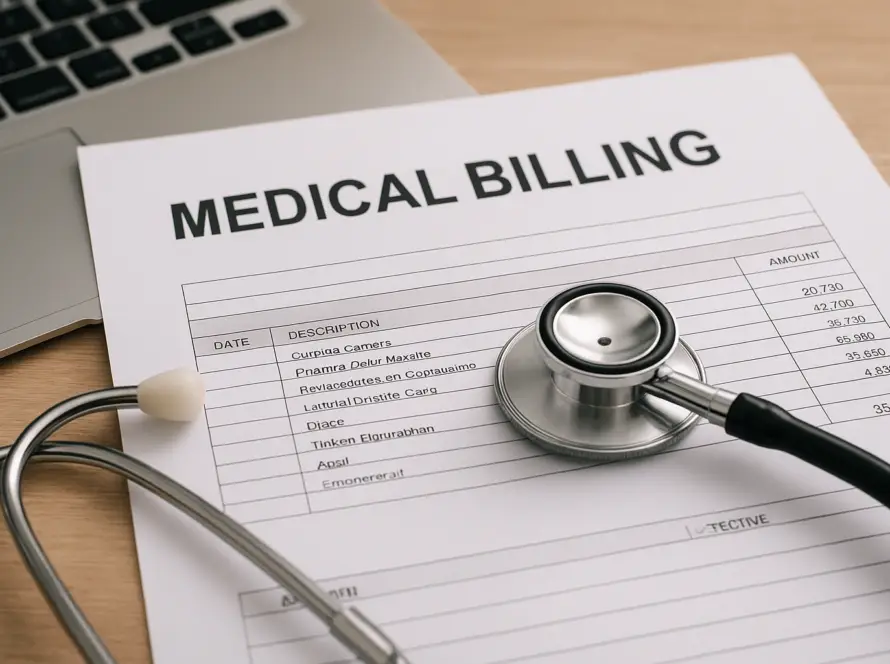Medical billing plays a critical role in keeping healthcare operations financially stable and compliant. Yet, without structured processes, practices can face denied claims, compliance risks, and cash flow delays. Adopting best practices in medical billing helps ensure clean claim submission, faster reimbursements, and improved operational efficiency. Let’s explore the fundamental principles every practice should follow to strengthen its revenue cycle.
Table of contents
Core Principles of Effective Medical Billing
Building an efficient and compliant billing system begins with mastering the core principles that shape every stage of the revenue cycle. These foundational practices, accuracy, verification, and timeliness help reduce errors, prevent denials, and ensure consistency in payments.
Accuracy in Coding & Documentation
Accurate coding forms the backbone of effective medical billing. Errors in CPT, ICD-10, or HCPCS codes can lead to claim rejections and compliance penalties. Billers should always cross-check documentation before submission and stay updated on quarterly coding revisions from authoritative bodies such as the American Medical Association (AMA).
Standardized templates and detailed provider notes also enhance accuracy and minimize the need for resubmissions.
Front-End Verification and Patient Data Integrity
Front-end verification ensures that the claim process starts correctly. It involves confirming patient demographics, insurance eligibility, and coverage limits before rendering services. Verifying this data at the outset prevents many downstream issues like claim rejections or balance billing disputes.
Consistent verification workflows also build patient trust by providing clear cost expectations and transparent billing communication.
Timely Submission and Monitoring
Submitting claims on time is essential for maintaining consistent cash flow and avoiding payer deadlines. Practices should utilize billing software that tracks submission dates, payer responses, and pending claims in real-time.
Regular monitoring and follow-up on unpaid claims reduces the risk of revenue loss. A well-structured timeline for billing activities helps ensure compliance with payer policies and facilitates an efficient revenue cycle.
Workflow Enhancements to Boost Efficiency
Improving efficiency in medical billing requires more than accuracy, it demands streamlined workflows that minimize manual effort, track performance, and empower teams to act proactively. Modern billing processes rely on automation, real-time insights, and clear team roles to ensure that every claim moves seamlessly from submission to payment.
Automating Claim Scrubbing and Follow-Up
Automation plays a vital role in reducing repetitive tasks and minimizing errors. Claim scrubbing tools automatically identify missing information, incorrect codes, or payer-specific issues before submission. This pre-validation significantly reduces rejections and denials, helping billers focus on higher-value tasks.
Automated follow-up systems also track claim status with payers, sending reminders or alerts for pending claims to ensure no reimbursement opportunity slips through the cracks.
Real-Time Analytics and Performance Dashboards
Data-driven decision-making is key to a successful billing operation. Real-time analytics tools provide valuable insights into claim turnaround times, denial patterns, and payment performance. Dashboards help administrators pinpoint bottlenecks and track KPIs like first-pass claim rate and days in A/R.
Regular performance reviews based on these metrics allow teams to make informed improvements that enhance both efficiency and profitability.
Staff Training and Role Clarity
Even the most advanced billing system can fall short without a well-trained team. Continuous staff training ensures billers stay updated on regulatory changes, payer requirements, and new coding updates. Clearly defining roles from eligibility verification to denial management prevents duplication of effort and accountability gaps.
Regular workshops and refresher courses also boost morale, reduce burnout, and foster a culture of excellence across the billing department.
Compliance-Focused Practices for Billing Teams
In medical billing, compliance is more than a requirement, it’s a foundation for financial integrity and long-term stability. With constant changes from CMS, AMA, and private payers, staying compliant ensures claims accuracy, reduces penalties, and protects sensitive patient data. Building a compliance-driven culture within your billing team helps minimize risk and maintain trust with both payers and patients.
Keeping Up with CMS, AMA & Payer Policy Changes
Regulatory updates are frequent and complex. Billing teams must regularly review updates from the Centers for Medicare & Medicaid Services (CMS) and the American Medical Association (AMA) to ensure accurate use of CPT, ICD-10, and HCPCS codes.
Monitoring payer bulletins and newsletters also helps identify policy shifts that could affect reimbursement or coding rules. At Practice Perfect, our experts continuously track these updates, ensuring every client stays compliant and protected from costly claim rejections.
Audit Readiness and Denial Prevention
Preparing for audits requires precision and transparency in every claim. Establishing internal audit processes helps detect errors before they trigger payer reviews or compliance flags. Teams should maintain organized documentation, including physician notes and code justifications, for every submitted claim.
Regular denial trend analysis also helps identify recurring issues and apply corrective actions, ensuring smoother audits and improved financial outcomes.
Secure Data Management and HIPAA Enforcement
Compliance isn’t limited to billing, it extends to how data is handled and stored. Following HIPAA regulations protects patient information from unauthorized access and cyber threats. Secure EHR systems, encrypted communications, and restricted data access are essential for maintaining confidentiality.

How to Track Success: Key Metrics & KPIs
Tracking measurable performance indicators is essential to evaluate how well your medical billing processes are functioning. By monitoring the right KPIs, practices can identify inefficiencies, strengthen compliance, and optimize revenue flow.
First-Pass Claim Rate
The first-pass claim rate (FPCR) measures how many claims get approved without rework or denial. A high FPCR (above 95%) signals effective claim preparation and coding accuracy. Regularly tracking this metric helps billing teams spot early signs of data entry errors or payer-specific issues before they affect cash flow.
Denial Rate and Reversal Rate
Denial rate reveals how many claims are rejected or denied by payers. Ideally, your denial rate should remain below 5%. Monitoring both the denial rate and the reversal rate (claims successfully appealed and paid after denial) helps assess team performance and payer reliability. Consistent denial analysis enables early identification of recurring coding or documentation problems that require corrective action.
Days in Accounts Receivable (A/R)
Days in A/R indicates how long it takes for your practice to collect payment after submitting claims. Lowering this number improves cash flow and revenue predictability. Practices should aim for an A/R average of 30–40 days. Regularly reviewing A/R aging reports and setting up automated reminders for unpaid claims helps maintain a steady revenue cycle.
Final Thoughts
Mastering medical billing best practices requires more than accuracy, it demands consistency, compliance, and continuous improvement. By aligning processes with strong verification, automation, and data security, providers can ensure sustainable revenue growth.
At Practice Perfect, we combine technology with deep industry expertise to help healthcare organizations streamline workflows, prevent denials, and maintain compliance effortlessly.
Talk to a Medical Billing Expert today to see how Practice Perfect can help your practice stay efficient and compliant.
FAQs
Accurate coding, front-end verification, timely submissions, and ongoing compliance monitoring are essential best practices that keep billing error-free and efficient.
Practices should review their workflows quarterly to ensure processes align with payer updates, compliance standards, and performance benchmarks.
Yes, automation improves claim accuracy, identifies missing data before submission, and minimizes manual errors that lead to denials.
Small practices should focus on HIPAA data security, up-to-date coding compliance, and accurate documentation to avoid penalties and delayed reimbursements.




